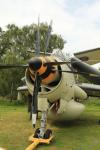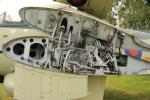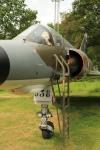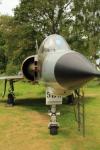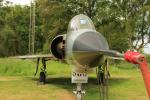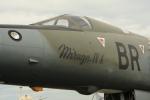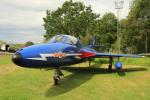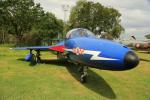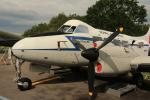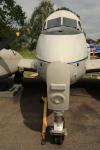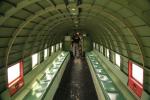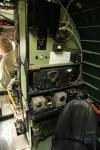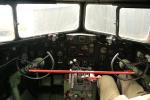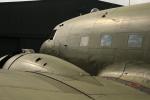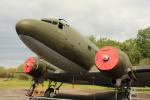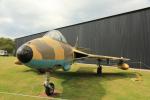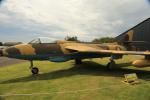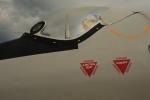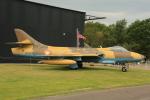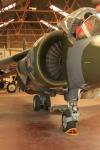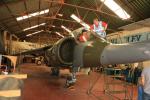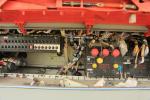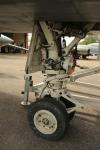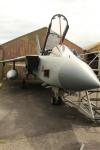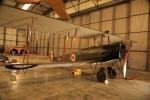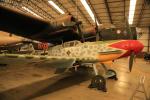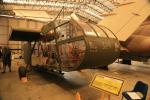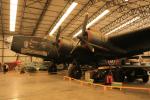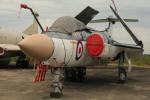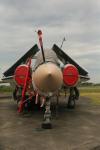Sunday 2nd June 2019
It was another bright and early start this morning as I headed up the A19 and onto the A64 on route to the Yorkshire Air Museum ‘Open Cockpits Day’ at Elvington.
This was to the best of my knowledge something quite new for the museum so I thought it would be quite interesting to go along and have a look around. Not really knowing what to expect I arrived early and joined the queuing traffic waiting to enter the museum.
Having checked in at the reception desk, signed an indemnity form and answered a few simple questions I was given a special wrist band and joined the throng of other visitors to look inside some of the cockpits of the aircraft at the museum.
I, am still quite familiar with most modern day fast jet aircraft cockpits and controls, but had never been inside the Nimrod MR2 XV250 or the Dakota 1V C-47B KN353 G-MAYJ, two significant aircraft, generations apart but both having played a substantial role in the protection of our country, so was hopeful that today I would be able to see inside them both. I made my way over to the Nimrod to book a time slot to look around the inside. Everyone else had the same idea as me so once I got my ticket I had some spare time which gave me the chance to have a look around some of the other aircraft on display.
Parked alongside the Nimrod on the apron was my old friend the Buccaneer painted in a Royal Navy livery, its wings folded up and airbrakes out it looked absolutely amazing. It took me back some fifty years when I first started work at Hawker Siddley as an apprentice aircraft fitter on the Buccaneer intakes, happy days.
Just round the corner from the Buccaneer was a Fairey Gannet AEW 3 XL502, wings folded back, a British carrier-borne aircraft of the post-Second World War era developed for the Royal Navy's Fleet Air Arm by the Fairey Aviation Company. It was a mid-wing monoplane with a tricycle undercarriage and a crew of three, and a double turboprop engine driving two contra-rotating propellers, originally designed for anti-submarine detection. Next to the Gannet a pencil thin Dassault Mirrage 111E 538 was parked up. A single-seat, single-engine, fighter aircraft developed and manufactured by French aircraft company Dassault Aviation. It was the first Western European combat aircraft to exceed Mach 2 in horizontal flight.
A Blue Hawker Hunter T.7 XL572 ‘571’ was the next aircraft I passed, a low profile cold war strike aircraft, this twin seat plane was used as a trainer aircraft to teach pilots how to fly other Hunters, it was later modified as a training aircraft for the Buccaneer.
Alongside the Hunter was a De Haviland Devon VP967 aircraft, built in 1948 and used primarily as a short haul airliner, used by both the RAF and Royal Navy. It retired in 1982 having spent many years as a fisheries protection aircraft patrolling the North Sea.
Just around the corner and situated in front of the Hanger was the C47 Douglas Dakota standing head and shoulders above the other aircraft. I was fortunate enough to climb on-board and spend five minutes in the cockpit chatting with the museum guide. This aircraft has had quite a working life, it was manufactured in Oklahoma City, USA, as a C-47B and entered RAF service at RAF Montreal in February 1945. In March 1945, it was transferred to 300 Wing in Australia and from May until December 1946 it served in Ceylon (now Sri Lanka) with the ACSEA Communications Unit. From then until October 1947, when it was returned to the UK at 12 MU Kirkbride, it was in the Far East. During transit back to the UK on its final approach at Castel Benito in Libya, the Dakota suffered double engine failure due to a bird strike. The pilot Flying Officer Alan Thame, landed the aircraft safely in spite of having no engine power and limited vision due to bird remains on the cockpit windows.
In February 1953, the aircraft was bought by Transair Ltd and registered as G-AMYJ. Subsequently, the Dakota was flown by many small operators, including a spell in Egypt with Nile Delta Services as SU-AZF, until it was bought by Air Atlantique at Coventry Airport for Pollution Control work in the early 1980s. G-AMYJ was used in the television series, “Band of Brothers” about the Airborne D-Day landings. A total of 10,655 C-47s were built and hundreds remain airworthy today.
After leaving the Dakota I headed over to have a look at the Harrier, which appears to be undergoing a repaint at the moment, it proved a big draw with lots of young children keen to have a look in the cockpit as did the Tornado GR4, two popular aircraft with the visitors today.
My time allocation to look around the Nimrod was getting close so I headed back to where it was parked for a tour around the inside of this iconic plane. Primarily a Cold War Maritime and surveillance patrol aircraft it retired from Service in 2010 after 41 years with the RAF. I remember it well from my time with the Search and Rescue Services as a well-respected aircraft. We entered the aircraft from the rear side door into the Acoustic Station where we were shown some of the equipment used to detect and monitor signals from the sonobuoys, from there we headed towards the flight deck and past the Radar Station, here we were shown the screens and dials that the operators would sit in front of watching the ‘Searchwater Radar’ which has a range of 200 miles. Continuing along the aircraft we came to galley and rest room, one of the most important places in the aircraft apparently, or so we were told. Further along we past the Navigators station were the Navigator sits alongside the Tactical Navigator both operators have vast amounts of data to analyse, the navigator responsible for getting the aircraft to where it is supposed to be going efficiently and on time whereas the tactical navigator is responsible for the control of weapons and ordinance. Sitting just behind the Flight Deck is the Flight Engineers position they were responsible for maintaining fuel, oxygen pressurisation and the electrical systems as well as monitoring engine performance. Finally we reached the Flight Deck which was manned by the pilot and co-pilot. There was a crew of between 11-13 all dependant on the type of mission being flown. Today this aircraft is maintained by a team of current and ex RAF ground crew. An interesting and fascinating tour of a remarkable aircraft.
On leaving the Nimrod I headed back to T2 hanger to have a look at one of my old friends the Buccaneer S2B XX901, the second Buccaneer in the museum, this aircraft has had an illustrious service record with the Royal Air Force. In 1983, it took part in the only deployment by Buccaneers to the Falklands and later saw action over Beirut. In the 1991 Gulf War it flew 14 operational missions and had the unique distinction of destroying a taxiing Iraqi transport aircraft with a laser guided bomb. It was saved from being scrapped by the Buccaneer Aircrew Association and is painted in the Gulf War colours, including the ‘Flying Mermaid’ nose art. Like the Tornado and Harrier there was a lengthy queue of visitors waiting to have a look in the cockpit.
There was quite a poignant art installation in the hanger around the huge Hadley Page Halifax LV907 called ‘Bootprints’ D-Day 75 “There but not there “in support of the Remembrance Charity which recognises the sacrifices made by Bomber, Fighter and Coastal Commands, plus the S.O.E directly in support of the D-Day invasion between the 30th May – 6th June 1944. 331 allied aircrew did not return. In this period the Bomber command lost 216 aircrew, 39 taken as PoW’s 25 Evaders and 14 injured.
Another fascinating aircraft that I looked at was the WACO Glider – the glider was only ever intended to be used once. The CG-4A was constructed of fabric-covered wood and metal and was crewed by a pilot and co-pilot, both of whom were expected to fight alongside the ground troops they were carrying once the aircraft had landed. It had two fixed mainwheels and a tailwheel. It was the most used American troop/cargo military glider during WW11. Whilst in service with the British military Service it was called ‘Hadrian’ and was used to deliver troops, Jeeps and guns into enemy territory in North West Europe, Italy and Burma.
The CG-4A could carry 13 troops and their equipment. Cargo loads could include a 1⁄4ton truck (i.e. a Jeep), a 75 mm howitzer, or a 1⁄4ton trailer, loaded through the upward-hinged nose section. More than 13,900 gliders were delivered during those war years.
Standing proud in the entrance to the hanger was the huge Handley Page Halifax mk 111 bomber. The Museum’s Halifax has been reconstructed from various sources; the fuselage is from a Halifax II, HR792, which carried out an emergency landing on the Isle of Lewis in 1945. A crofter, Mr McKenzie, purchased the fuselage section for use as a hencoop. The wings came from Hastings, TG536, at RAF Catterick. The reconstruction is named “Friday the 13th” in honour of Halifax, LV907, which completed 128 operations with 158 Squadron, and is representative of all examples built. The Halifax III was powered by Bristol Hercules engines. Primarily a heavy bomber, the Halifax III and later versions also served in Coastal Command and in paratrooping and glider towing roles with the Airborne Forces. There was a total of 6,178 aircraft manufactured, the bomber versions flew a total of 75,532 sorties during the Second World War.
After leaving the hanger I made my way over to the NAAFI for a late brunch, stopping on the way to have a look in the control tower, now a grade 11 listed building, the tower has been refurbished and restored and today it looks as it would have done back in the 1940’s. It is certainly very life like and I was certainly startled when I reached the top of the stairs and looked into the air traffic control room.
The spacious NAAFI is situated closely to the Control Tower and can accommodate up to 200 diners. It sells a wide range of hot meals and beverages every day throughout the year, I enjoyed a very pleasant cooked meal before I reluctantly left for home.
|

